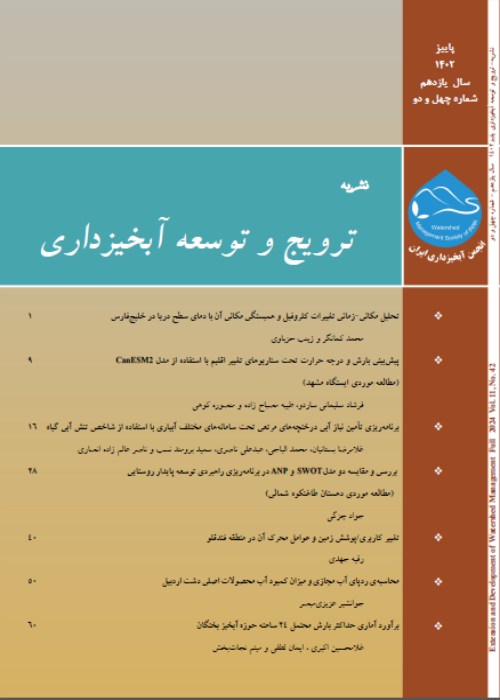The effect of flood spreading on the changes of different parameters of vegetation cover and soil seed bank (Case study of Sarchahan flood spreading in Hormozgan)
One of the most common and conventional methods of artificial feeding of aquifers is the flood spreading method, which feeds underground water tables, increases the quantity and quality of vegetation, and improves the soil of the plains. This study aimed to investigate the effect of flood spreading on the process of quantitative changes in vegetation cover and the effects of flood spreading on the soil seed bank in the Sarchahan flood-spreading area of Hormozgan Province over a 25-year period (1996–2022). Sarchahan flood dissemination station is located 90 km north of Bandar Abbas. The investigation method was such that the flood-spreading area of Sarchahan was chosen as a treatment, and a similar area in its vicinity was selected as a control in terms of vegetation and soil, which only had silage. In this research, 4 irrigation networks and three dams, in each network (flood spreading area) and 3 transects in each dam and 10 plots of 4 m2 in each transect to measure different vegetation parameters as sampling units within the flood spreading system in a random systematic way and the same number of transects and plots in the non-drained field were selected as witnesses and measurements and statistics were carried out. In order to check the seed bank, soil samples were taken from 20×20 cm microplots and from 0 to 5 and 5 to 10 depths from the four corners and the center of each plot. Soil samples were planted in the greenhouse of Hormozgan University to check the seed bank, and after germination and identification of plant species, all vegetation cover and seed bank data were analyzed with the help of SAS software. The results showed that the effect of flood spreading on the coverage percentage, production rate, litter percentage, rock and gravel percentage, density per hectare and sediment depth was significant at 1% level and the coverage percentage, production rate, litter percentage, density per hectare and sediment depth in the control treatment were 19.56, 42.6, 1.49%, 5438 bases, and 0.64 cm respectively after flood spreading operation, respectively. 2, 3.9, 2.8, 2.6 and 17.3 times increased. A comparison of the average biological indicators of vegetation in the first and second soil depths among the different treatments using the independent t-test at the 95% level showed that the biodiversity of vegetation in the first and second soil depths at the flood-spreading site was more meaningful than witness that of the witness site. Simpson and Shannon's biodiversity, Sheldon's and Brillion's uniformity indices, and Menhinick's and Margalf's richness index were significantly higher than the control at both depths in the flood spreading site.
- حق عضویت دریافتی صرف حمایت از نشریات عضو و نگهداری، تکمیل و توسعه مگیران میشود.
- پرداخت حق اشتراک و دانلود مقالات اجازه بازنشر آن در سایر رسانههای چاپی و دیجیتال را به کاربر نمیدهد.


